Your cart is currently empty!
FREE Lesson 4 – What is weave diagram (or put in paper)?
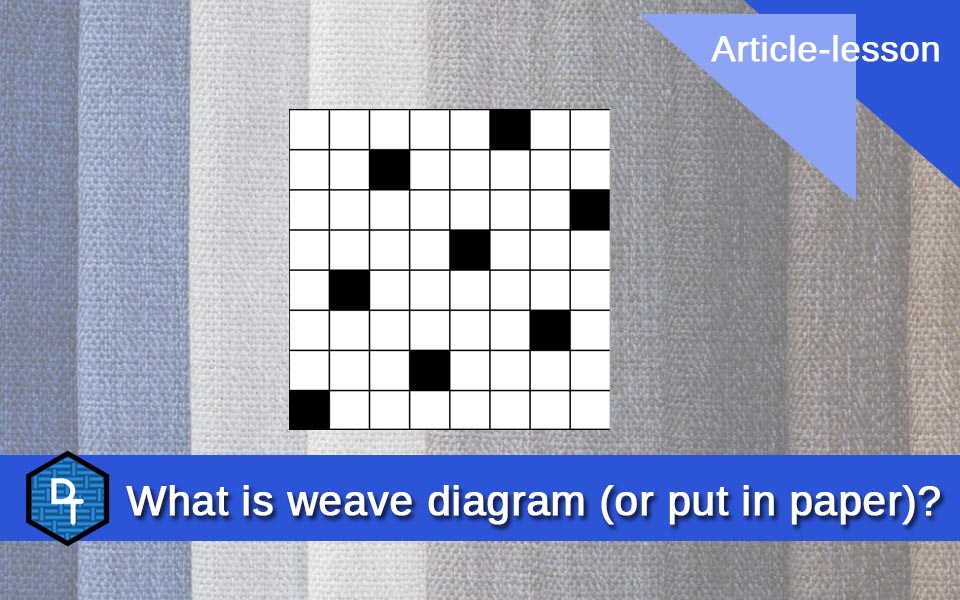
FREE Lesson 4 – What is weave diagram (or put in paper)?
Answering the question, What is “weave diagram” or “put in paper”? It might be in its definition easy enough to say.
But since in this article-lesson, I want to explore a bit more, I won’t stop at just a definition of it.If perhaps you’ve already read my previous article-lesson, in which I explained in detail what the basics of creating a fabric are (you can read it by clicking HERE), you’ll find it easier to understand the usefulness and use of weave diagram, which is basically a procedure, but also a more physical “something”. It’s basically terminology that can be used in two ways.
If you think about it “weave diagram” or “put in paper”, is a terminology in itself very clear and at the same time “mysterious”.
Reading these words: “weave diagram” or more from italian language, how we are abit to talk “put in paper”, without even knowing what you are talking about, you might think it is about something that is put on paper, right?
In fact that’s exactly how it is, or rather originally it was, today it’s a little different.
But what is, or was, “put in paper” or “weave diagram” ?
Logically because we talking about weaving, it is something about the subject, certainly not talking about something in general!Well, now and after this premise a bit long, to introduce you to the subject, I start to give you a first definition of “waves diagram”, or “put in paper”, let’s say the one concerning the procedure:
“Put in paper” is that operation that the textile technician performs in order to represent on paper (a kind of code), the interweaving of the vertical threads with respect to the horizontal ones of a fabric, also called weaving.If you look at a fabric very closely, perhaps using a magnifying glass, you will realize that it is normally NOT like a sheet of paper (i.e. a flat, continuous surface).
In reality (although there are various techniques for making a fabric, and there are even fabrics called “faux”), fabric is a collection of vertical and horizontal threads that intertwine with each other, and this forms what we all call fabric.
Which then forms the basis of all the clothing and textile artifacts we use every dayAnd now we come to the second definition of “put in paper” or “waves diagram”, which is, however, totally connected to the first:
“Put in paper” is also the design, or graphic code that represents (precisely on paper), through the use of black and white squares, the weaving of a fabric.
So, as you can see, “put in paper” can have this double meaning, even if normally in the books that are studied (and that I have studied), in schools that teach weaving, only this second definition is generally used.
But for a particularly in-depth analysis, I believe after many years of experience, that the “put in paper” is better explained with this double meaning, which I think is even more complete.You should now have come to sufficiently understand the concept.
But why was this procedure/design devised?The simplest reason is very similar conceptually to why at some point human beings felt the need to invent writing:
To be able to have a fairly simple means of “describing”, in this case a fabric, and subsequently being able to reconstruct it by means of special machinery (the looms), and also to be able to archive it and allow other people to be able to “pass it on”, know about it and use it.Below I’ll show you two images, the one on the left represents a drawn “enlargement” of a simple fabric, and on the right you’ll find the “put in paper” that represents it.
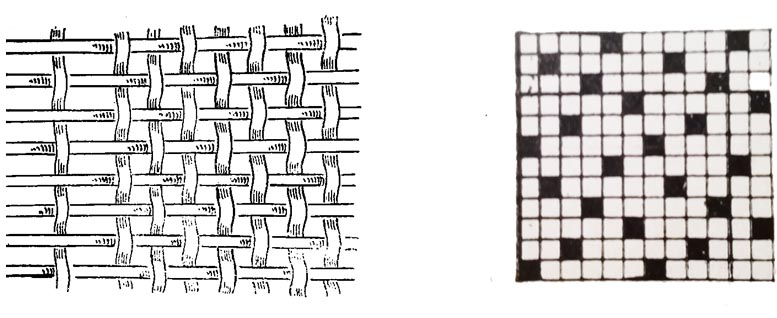
But how do you read the black squares and the white squares to understand how to weave/reconstruct a fabric through the “put in paper” or “weaves diagram”?
The concept is really very, very simple.
- When a square is colored black it means that the vertical thread (called warp), passes over the horizontal thread (called weft).
- When the square is white it means that the vertical thread (warp)under the horizontal thread (weft)
Therefore the set of black and white squares defines with simplicity but with extreme precision how a fabric evolves in its weave and in this way, as when we read a book, we can “read” and make the looms weave the corresponding fabric.
If you’ve made it all the way through this article-lesson, you should now have a very good understanding of what “put in paper” or “waves diagram” is, and also what it’s for.
Yes, because the “put in paper” has many other rules to follow in order to be used to represent and reconstruct particularly complex fabrics.
But we will see all this a little at a time, in the next articles-lesson.See you soon in the next article-lesson!
If you think this article-lesson might be of interest to someone else you know, share it and you’ll be doing them a favor!
Great 1° question: How do you make a fabric?
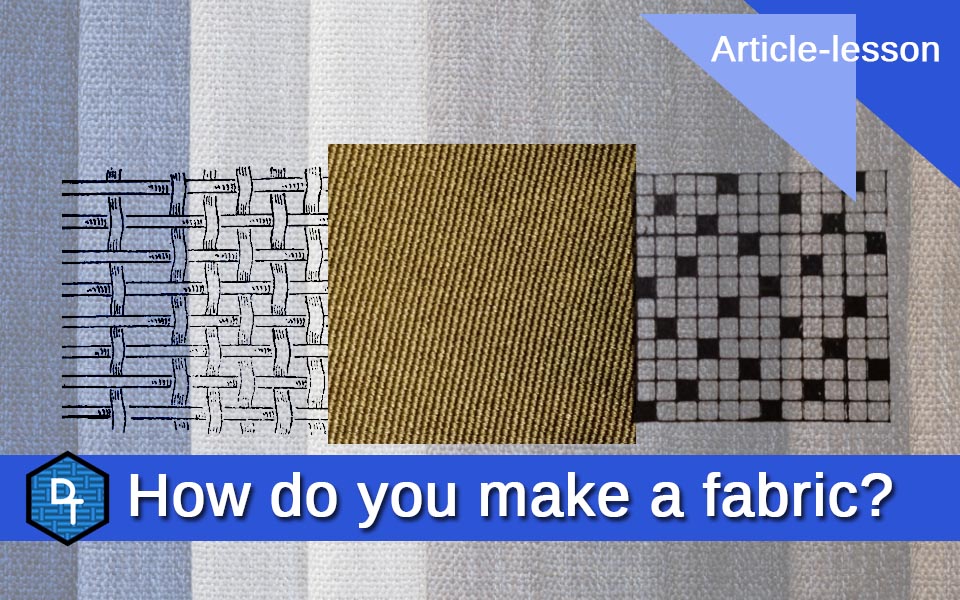
How do you make a fabric?
I must say that to answer in a truly complete at he question: how do you make a fabric, it would take a particularly in-depth study plan, as happens in specialized schools, given the vastness of the subject.
However, in this article I can definitely give you an introductory answer to make you understand some very useful basic concepts, and a first methodology to apply.
Let’s start right, from the basics: Normally to create a fabric, apart from all the various existing techniques, you can choose two paths.
The first path, is to give vent to your imagination and design a “new” type of fabric from scratch, with the characteristics you want. Let’s say that even if it is the most beautiful and artistic way, it needs to have a certain technical preparation, and also possibly a good experience. Therefore, for those who are just starting out, it is a methodology that is not feasible.
The second method, however, also used by experts in the industries, is also feasible by those who have no experience or a complete study of the subject. In practice it consists in the analysis of an existing fabric, and its reconstruction on paper, possibly reworking it in a slightly different way from the original, to create something new.
This method is practicable even at home and with very few tools.But in a business setting, which of the two methods is best?
There is no real rule really, it depends on the situation.
Let’s take the case where a customer wanted to reproduce an ancient fabric, of which there are no longer all the data to be able to make it directly, the only solution would be the analysis of that fabric and its reconstruction.On the other hand, if you wanted to create a fabric using your imagination, you could very well follow the first path, or a mix of the two, perhaps taking a cue from an existing fabric, and then making something totally different.
In this article, I’ll explain the basics of the second type of path, which on the one hand is “easier”, and on the other hand is the only way to go if you don’t already have a basic study, or experience.
But what does it mean to analyze a fabric?
Analyzing a fabric means finding out how the threads that make it up cross each other, and marking these data with a special coding on paper or by computer with specific software.
Basically, to perform this analysis, the simplest way possible and also the oldest in the true sense of the word, is to have a square paper, a pencil, a magnifying glass and logically the fabric to be analyzed.
But how does this work, or rather what do we have to do?The concept itself is simple: we need to observe how the vertical threads move relative to the horizontal threads, and create a mapping of these evolutions.
Let’s get started right now and see how it’s done in practice for to response of the question: How do you make a fabric?
We take a cloth that we are interested in analyzing, cutting out a small piece of it, large enough to contain the complete structure of the cloth, i.e. the minimum repeatable ratio.
To figure out what the minimum repeatable ratio can be, since we don’t really have numerical data to know, we need to exploit our most natural “skill”, which is the ability to observe.
Now, we take the piece of fabric, place it on a table, I recommend to illuminate well the surface possibly with a white light lamp, and begin to fray it.
Fraying means removing from the edges a certain number of threads, both vertical and horizontal, to allow you to see them well, and without them being intertwined with each other.
Below you can see an example: the fabric on the left is the starting fabric, the fabric on the right is the same after performing the operation just explained.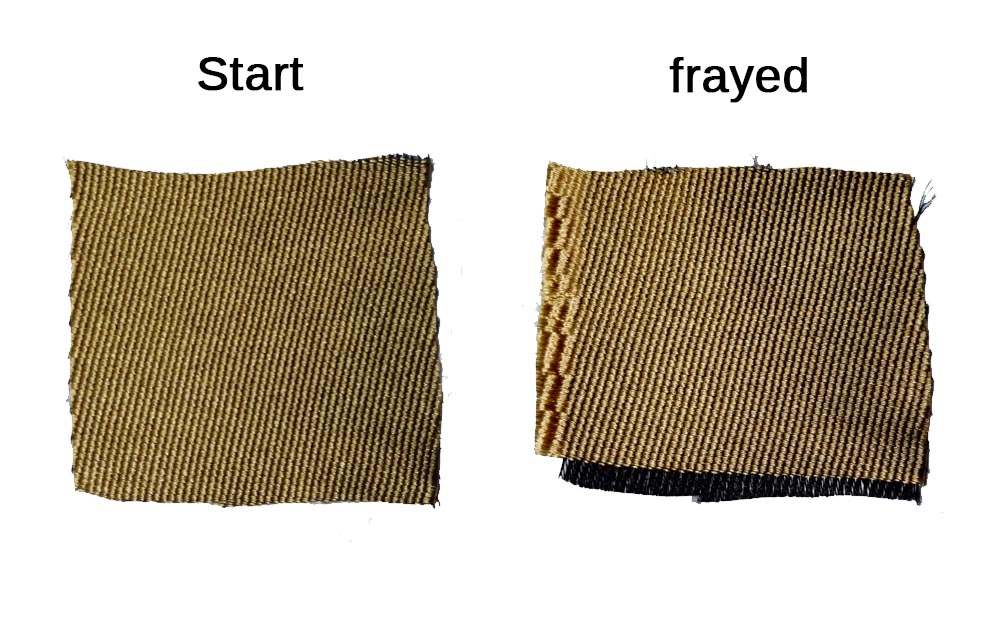
Now start with the first vertical thread (left side), and separate it a lot from the other threads, so you can see it very well.
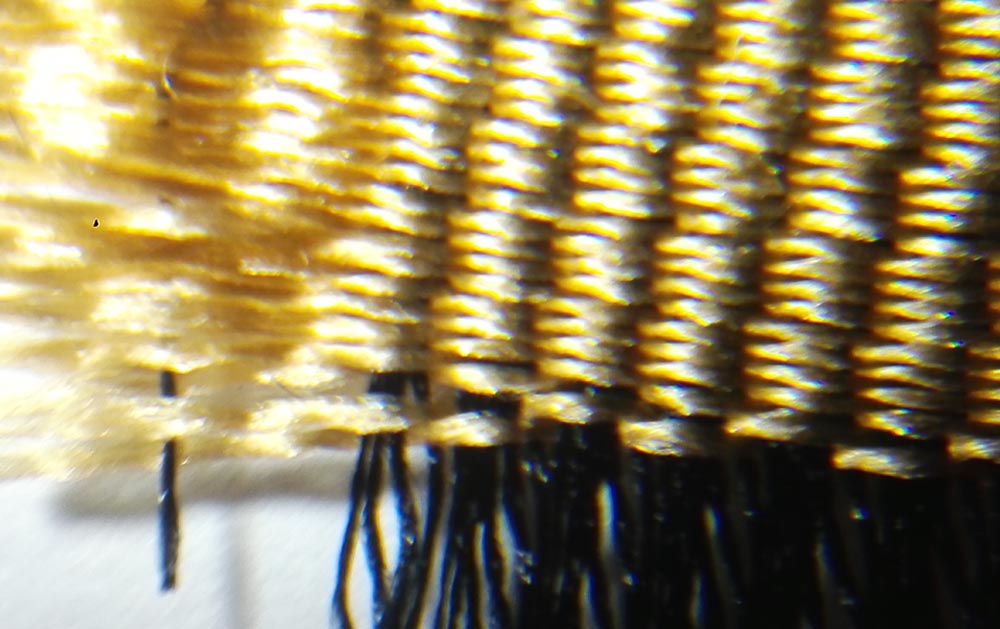
the photo was taken with a special magnifying glass Now you take a small lens, usually a special very small magnifying glass, made especially for this procedure (you can see it in the image below), and start to observe the evolution of the vertical thread compared to the horizontal one.
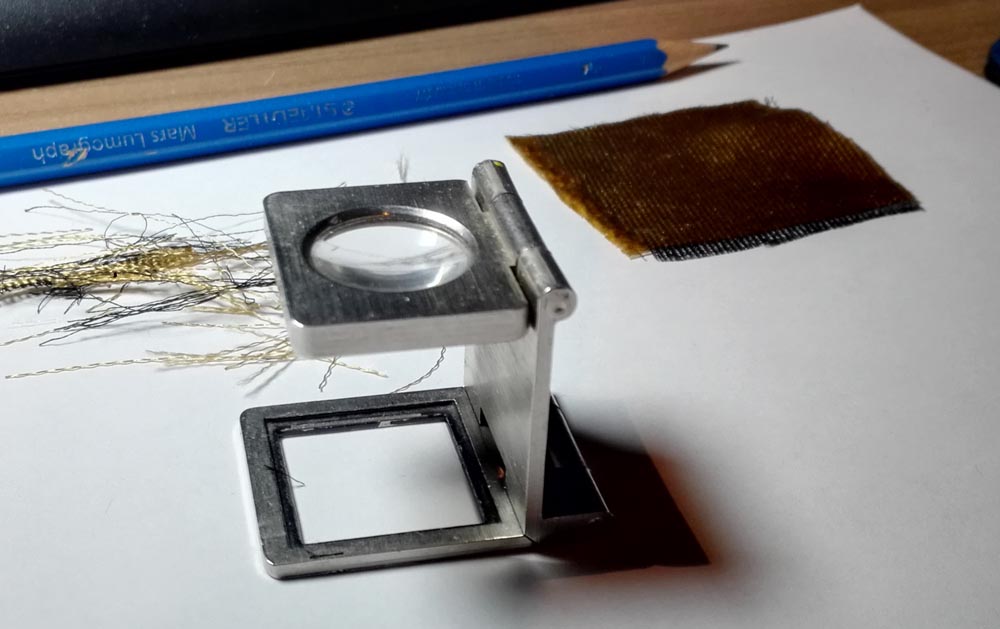
After a very first general observation, useful to understand a little bit the type of evolution, we really start with the real analysis phase.
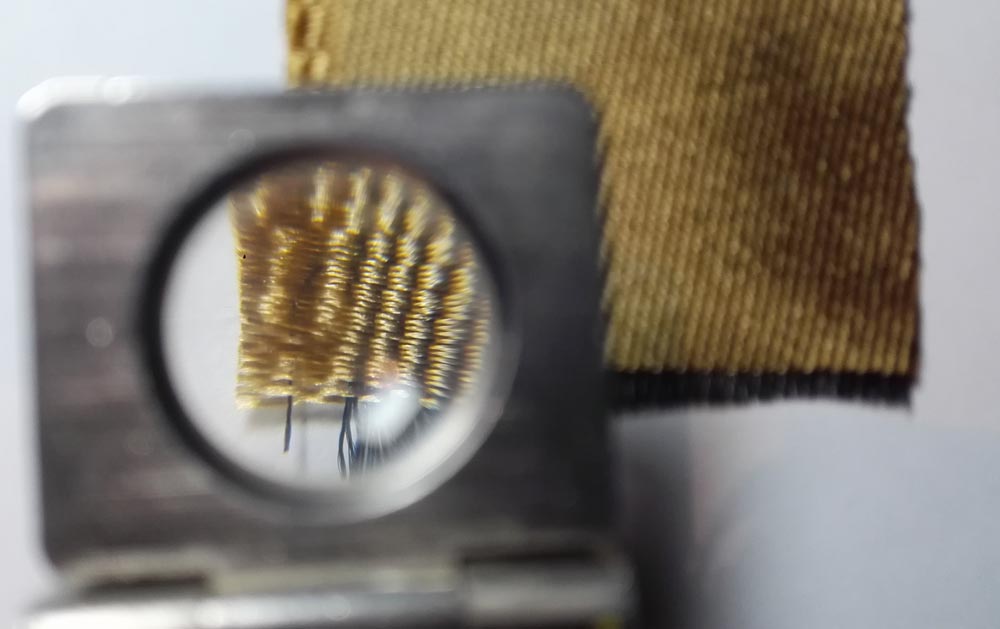
The method to use is as follows:
When the vertical thread (warp) passes over the horizontal thread (weft), color the first square on the sheet with a normal black pencil (you can choose the first square where you want it on the sheet). When you see that the vertical thread passes under the horizontal thread, leave the square empty, i.e. do not color it.
If you dont know well what are weft and warp, you can read this other article-lesson: What is a textile?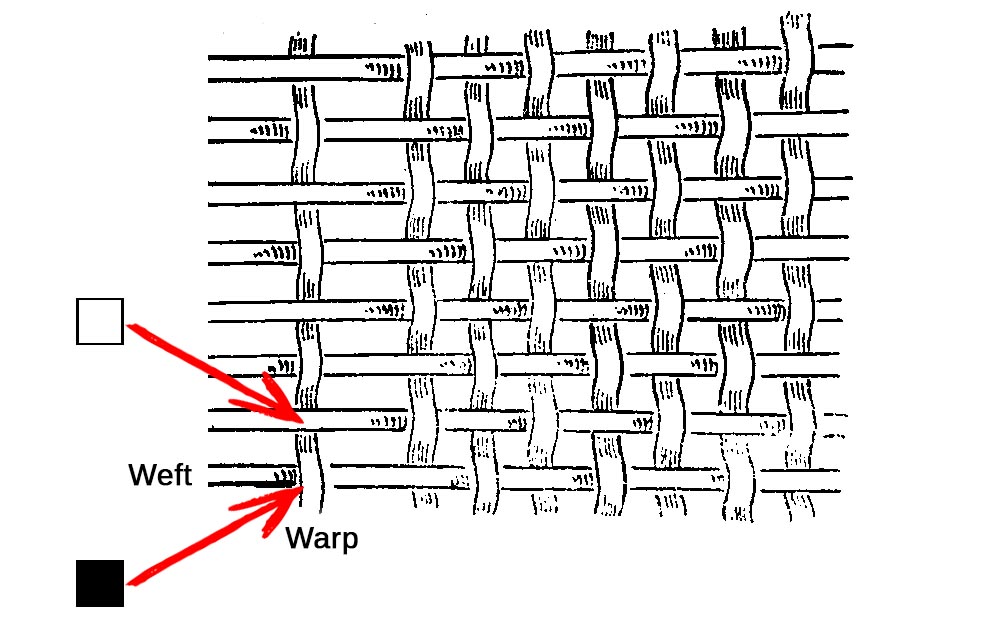
This procedure is to be repeated vertically for the first thread, until a perfect repeatability of the sequence of black and white squares is found.
The minimum possible value of repeatability is 2 squares vertically (2 wefts), up to very large numbers indeed.
As you will understand, this type of analysis requires a great deal of attention and patience, and in the case of particularly elaborate fabrics even a long time.
When you have discovered the first repeatable ratio of the first vertical thread above the various horizontal threads (i.e., wefts), you will have the entire ratio of the evolution of the first thread of the fabric, which will also indicate the total size of the entire structure in the Y direction of the entire fabric.
Now we must continue with the second vertical thread, moving to the right and removing the previous one that is no longer needed. At this point we repeat the entire analysis made on the first vertical thread, also on the second thread, and so on until we find a perfect repeatability of the evolutions also in the horizontal.
After finishing this procedure you will have found the entire weave structure of the fabric and have the basic data to be able to recreate it.
In the image below you can see a simple structure of a fabric reported on paper with the method described, (it is not the structure of the weave of the photo of the fabric seen above), where with the red box I have highlighted the repeatable ratio both as vertical threads (warp), and as horizontal threads (weft), which is 6 x 6.
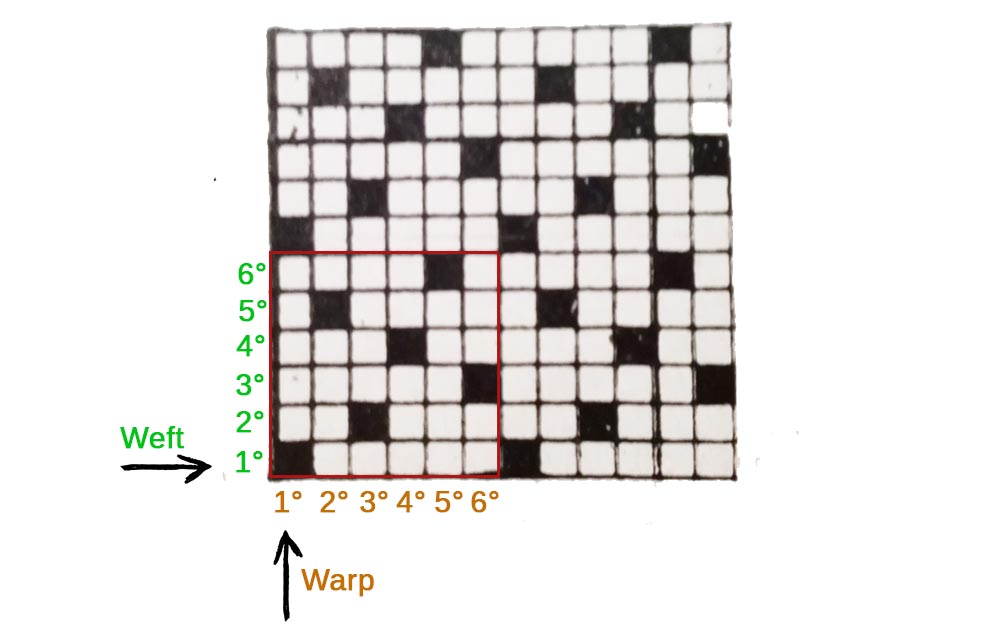
But how is it possible to use this checkered pattern, that is, this mapping of the evolutions of the threads on the wefts, to then recreate a real fabric?
On the theoretical side, i.e. still in the design phase there are further various phases, which do not concern this article-lesson, on the practical side, once all phases are finished you will have a complete coding, which can be used on the loom to weave the new fabric. But I will talk about this in future articles.
Perhaps, among the many questions that might now come to mind, there might be this one:
But which threads are vertical and which are horizontal? Since I can spin the fabric, and there doesn’t seem to be a default horizontal or vertical?The answer is more complex than you might think.
In order to recognize which is the true vertical side and which is the horizontal side, it is necessary to carry out a more in-depth analysis of the product type (i.e. the nature of the yarn) and of the technical type.
Thanks to these successive analyses, which can be done only after having studied the relevant methods, it will be possible to understand almost 100% which is the vertical side and which is the horizontal side of the fabric. Understanding this is fundamental, otherwise you won’t really be able to weave the fabric correctly!Let’s say that for a first phase of study and analysis, at the moment understanding which are really the vertical threads (warp), and the horizontal threads (weft), is not fundamental. But when you have to make a real fabric, it will definitely be, in order to avoid even real production disasters.
For this article-lesson, we’re done, and if you made it to the end of this article lesson: how do you make a fabric, thank you, and I hope I was helpful!
Now you know what the basic technique is, and the first one you study to start learning how to make fabric!See you soon!
If you think this article might be of interest to someone else you know, share it and you’ll be doing them a favor!
“Super special 100% question”: WHAT IS TEXTILE (fabric)?
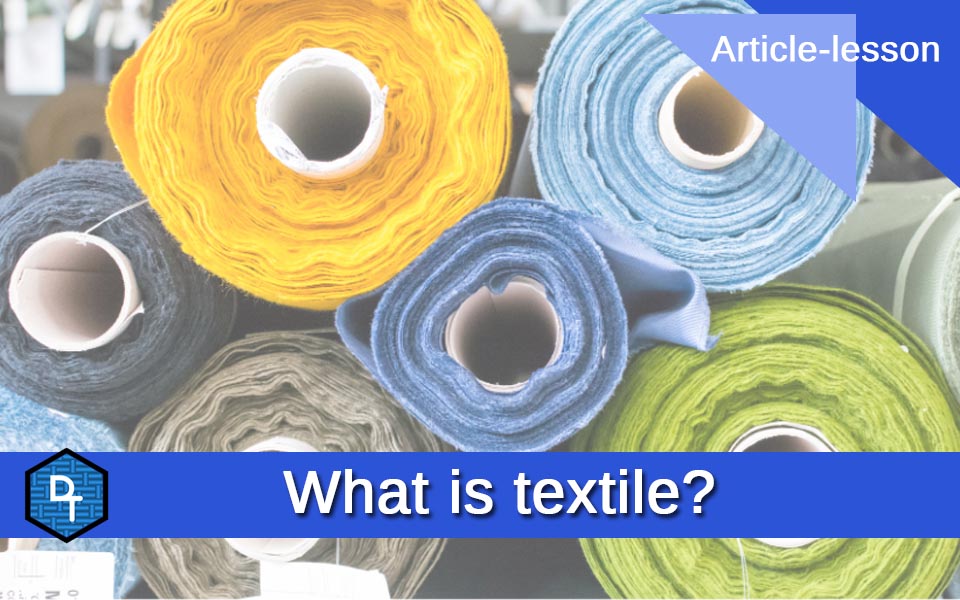
What is textile ?
(fabric)What is textile really, have you ever wondered?
But before I give you the answer to that question, I start this article, with a thought, a reflection.
Over the years, when I’ve talked to people about my work, I’ve noticed that a lot of them didn’t know much about the world of weaving, nor were they even clear about what a fabric was and especially how it’s made.
Lately I have also been searching a lot on the internet to see what information can be found about this area; with some amazement I have noticed that very little information can be found, especially the more technical information.
So I thought I’d try to fill that gap by blogging at Designs for Textiles about informative and technical articles on the subject.
In time I will also talk about the various and main techniques of weaving from design to production, making better known also the beautiful world of Jacquard fabrics, among the most difficult and beautiful to make.
I start this first article by starting from the basis of everything, giving an answer to a simple question, which, however, has an answer at bottom more “complex” than you might expect.
So, returning to the title of the article, What is textile?
If we wanted to simply define a fabric, we could say that it is an apparently “two-dimensional” object, since it is very fine in its third dimension, made from the interweaving of many threads that join together to create a soft surface, often also very resistant, and easily workable.
Let’s say that the definition alone, doesn’t really explain what a fabric is, and its real characteristics.
If you try to look at a fabric, especially the finest ones or those with a very compact surface, they might seem like large sheets of paper, very soft and malleable.
In reality, fabrics are anything but.If we looked much more closely at a fabric, using even a normal magnifying glass or even zooming in with our smartphone camera, we could well see that the surface of a fabric is very distinctive.
Although there are many techniques for making textiles, most are made from very fine threads that are woven together in various ways, and through this interweaving the fabric is created.
Look at the image below, what you see is a thread, specifically a silk thread.
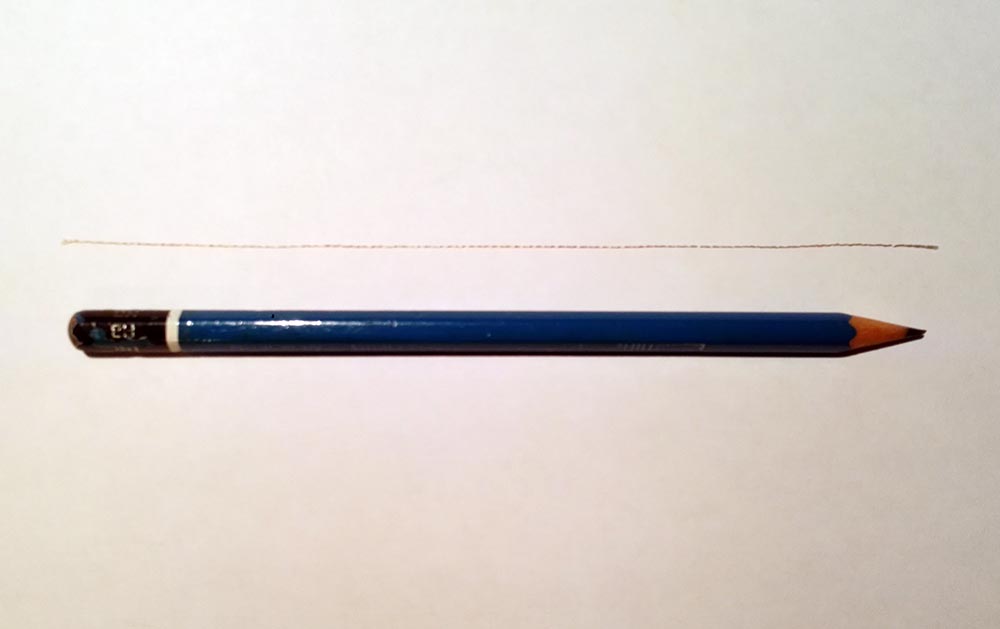
As you can see by comparing it with pencil in the picture, it is really very, very fine, and it is from this thread that you can start to make a strong fabric with a surface also very compact, but still soft and easily workable.
In fact, at the base of the technique to make most of the fabrics we have a complex operation of crossing the wires arranged in a longitudinal direction with others arranged in a transverse direction.
The threads arranged longitudinally are called CHAIN OR WARP, and are wound on cylinders, now made of metal, once made of wood, called BEAM, which are then placed in the back of the machine used to create the fabric which is called: LOOM.
On the other hand, the threads arranged in transversal direction are called WEFT, and are those that are passed with various evolutions, through a special mechanism, between the various threads of the WARP, thanks to the LOOM, which creates the fabric.
But how is it possible for such a lightweight thread to move between the various warp threads arranged longitudinally creating a weave and consequently a fabric without creating a disaster?
Although the mechanism itself is quite complex I can explain it to you in a fairly simple way.
Do you see this object?
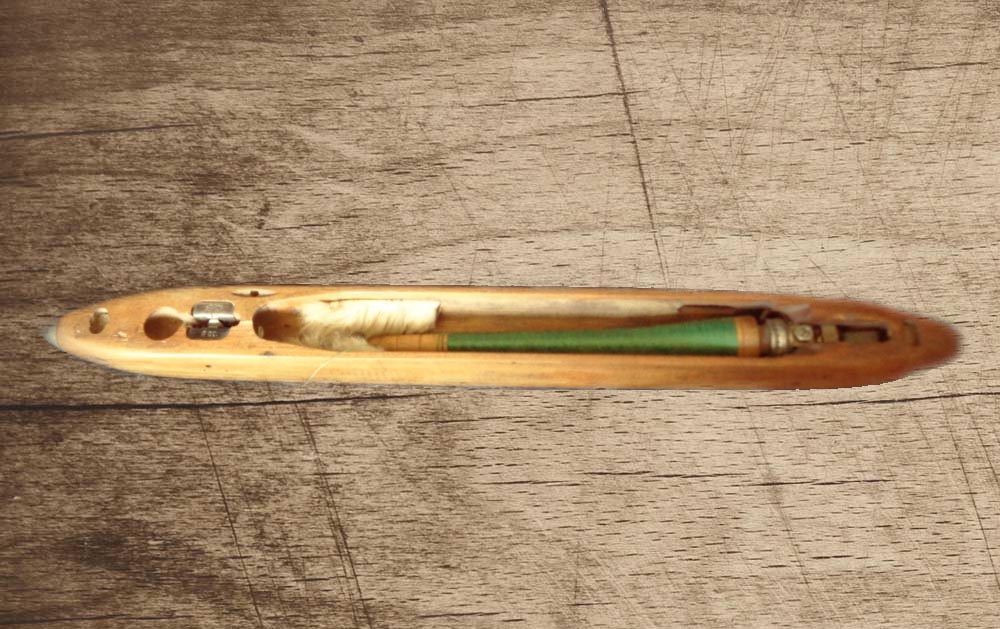
dav It’s called a SHUTTLE, it almost resembles a spaceship body, and in a way it could be “a spaceship”, but not for testing human beings, but threads, i.e. WEFT, one at a time, between the warp threads. Fascinating, isn’t it?
(I immediately want to point out that today with modern looms, no longer use the shuttle, but other systems that are based on the same concept.)But how does this shuttle manage to get each weft thread to the end of its “journey” without strange knots or breaks in the various warp threads happening?
in reality, the many warp threads are not stationary, because thanks to particular mechanisms they are moved up and down with predefined sequences that allow the weft, launched together with the shuttle by a mechanism, to intertwine with the warp threads.
At this point one might wonder… but if the warp threads are so light and soft, how can they manage to withstand the speed and air displaced by the shuttle launched toward them without creating a disaster?
The method that was invented a very long time ago is as ingenious as it is simple.
Do you have in mind the comb you use to comb your hair?
That’s it, the warp threads are passed from 1 to more in equal numbers through some sort of very long comb throughout the height you want to give a fabric.Thanks to the passage between the tensioners of this special comb the warp threads are kept parallel in a perfectly regular way, thanks also to a tension that is applied, and this allows to raise in an orderly and precise way all the threads at the passage of the shuttle and consequently of the weft.
This is what happens to allow the weft to be interwoven with the warp.
As you can guess therefore to make a fabric is something very complex.
The basic method that I have just explained, is not the only one, but it is the one used in most fabrics.Surely you have in mind that some fabrics have designs on their surface, in some cases they are printed as if it were on a sheet of paper, in other cases they are made with a special technique called: Jacquard.
From the next article we will delve into the fascinating techniques of fabric making!
See you soon!
If you think this article might be of interest to someone else you know, share it and you’ll be doing them a favor!
1° useful article-lesson – Jacquard Loom – What is it?
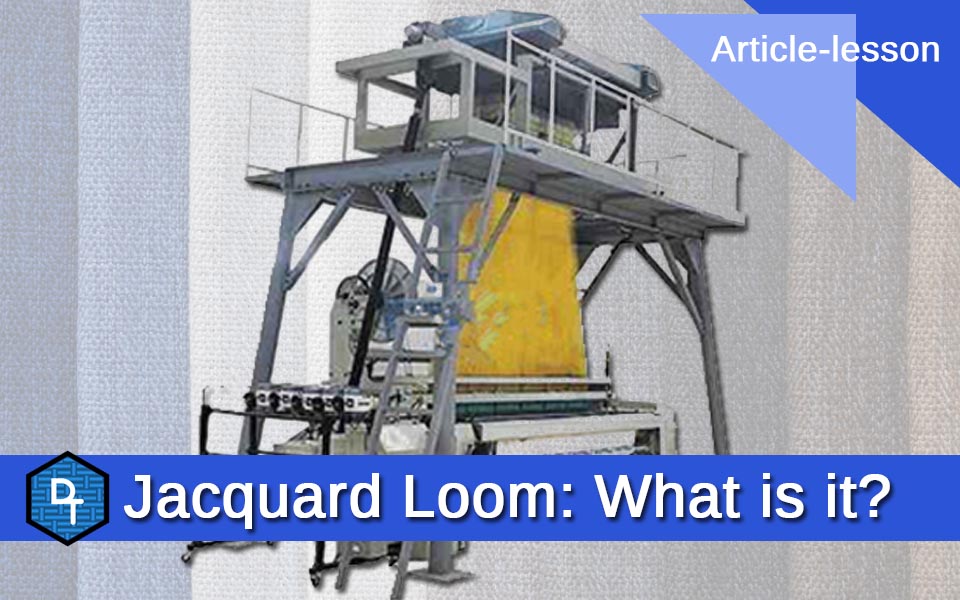
Jacquard Loom: What is it?
Before explaining what a “Jacquard loom” is, for those who are not already aware of it, it is better to clarify what is meant in the textile field by the word loom.
By loom we mean the machinery that makes the fabric with various methods and mechanisms.
Practically all the fabrics that you find on the market either in finished form, such as clothes, or in “raw” form, i.e. still in the form of a piece and/or roll of fabric, are made using looms.
The looms, which are one of the many inventions of the human being, have existed for many hundreds of years, and even in ancient times there were the first rudimentary looms. Logically, before the birth of mechanical and electrical systems, the looms were moved by hand by one or more people.
Still today there are hand looms in many parts of the world, but generally in the most modern industry, for several decades now these machines are mechanical/electric.
Before explaining what a Jacquard loom is, it is useful to understand the principle behind every type of loom, both yesterday and today.
At this point we are ready to understand what a Jacquard loom is.
The jacquard loom, being a loom, is obviously a machine for making fabrics, but with a very particular methodology invented in France in 1801 by Joseph-Marie Jacquard, from which it takes its name.
The great innovation that Jacquard made, compared to the existing looms up to that moment, was as “simple” as it was truly revolutionary.
In practice, thanks to the Jacquard loom it is possible to have the total independence of each vertical thread in its movement, independence that practically allows you to weave fabrics with very large designs of all kinds.
To understand the big difference from the “normal” loom, called a heald or dobby loom, thanks to the jacquard loom it is technically possible to weave even a complex image like the famous painting by Leonardo da Vinci the Mona Lisa, or any other kind of very nuanced image with very different shapes.The jacquard loom is therefore still today, more than 200 years after its birth, the most important and innovative invention ever made by human beings in the textile field, since the birth of textile art, and the fabrics made with this type of loom can be among the most valuable in the world.
If you think this article might be of interest to someone else you know, share it and you’ll be doing them a favor!
Learn textile art easily : Presentation
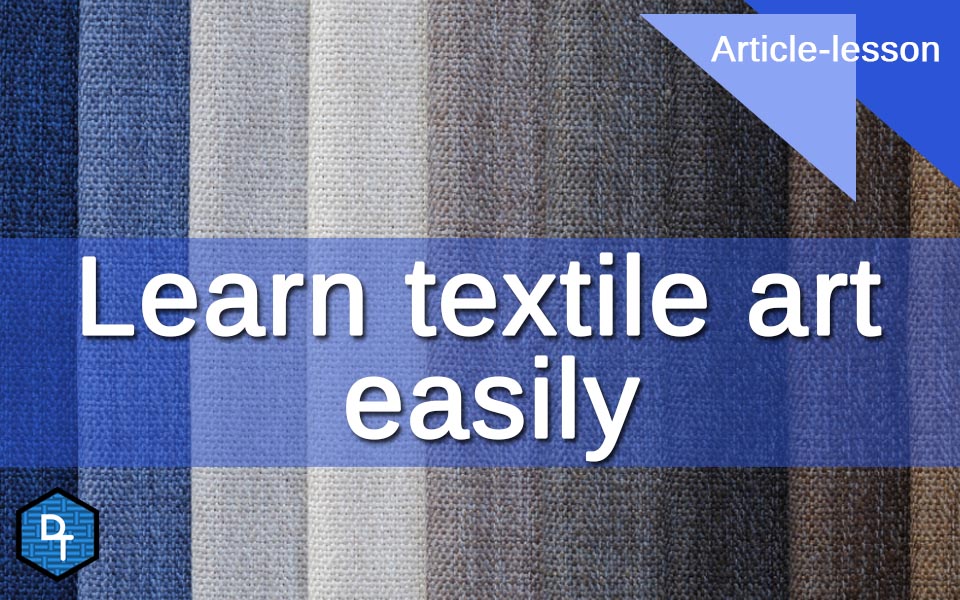
Learn textile art easily :
Presentation
With this first article we want to introduce the new section of our blog that we decided to call: Learn textile art easily, and that is located in the category: Textile Course.
You can find it at this link:
https://www.designs-for-textiles.com/category/textile-course/With these articles we intend to give a free contribution to all the students who live day by day the intense and complex study of weaving.
These articles-lessons logically do not want to replace, and it would not be possible, a course made in a specialized school, but a support, thanks to a convenient online documentation designed in the simplest form possible, and suitable to help all students of this industrial and creative sector.
Some articles are already online, and they start with the basic fundamentals that all students need to understand and learn to get started.
Our articles-lessons will be aimed primarily at the field of jacquard weaving, and also at healds with everything related to this world.
Since Jacquard weaving is one of the most complex in the world, but also the one that allows for the most artistically evolved fabrics, it will be the most discussed topic.
We hope to do a useful service to all students everywhere, especially in this difficult period caused largely by the still strong emergency of the covid-19 pandemic.
Happy reading and happy studying!
Designs For Textiles
If you think this article might be of interest to someone else you know, share it and you’ll be doing them a favor!